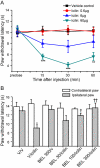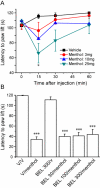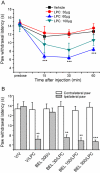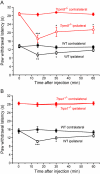The roles of iPLA2, TRPM8 and TRPA1 in chemically induced cold hypersensitivity
- PMID: 20092626
- PMCID: PMC2822744
- DOI: 10.1186/1744-8069-6-4
The roles of iPLA2, TRPM8 and TRPA1 in chemically induced cold hypersensitivity
Abstract
Background: The cooling agents menthol and icilin act as agonists at TRPM8 and TRPA1. In vitro, activation of TRPM8 by icilin and cold, but not menthol, is dependent on the activity of a sub-type of phospholipase A2, iPLA2. Lysophospholipids (e.g. LPC) produced by PLA2 activity can also activate TRPM8. The role of TRPA1 as a primary cold sensor in vitro is controversial, although there is evidence that TRPA1 plays a role in behavioural responses to noxious cold stimuli. In this study, we have investigated the roles of TRPM8 and TRPA1 and the influence of iPLA2 on noxious cold sensitivities in naïve animals and after local administration of menthol, icilin and LPC. The roles of the channels in cold sensitivity were investigated in mice lacking either TRPM8 (Trpm8-/-) or TRPA1 (Trpa1-/-).
Results: Intraplantar administration of icilin evoked a dose-dependent increase in sensitivity to a 10 degrees C stimulus that was inhibited by iPLA2 inhibition with BEL. In contrast the cold hypersensitivities elicited by intraplantar menthol and LPC were not inhibited by BEL treatment. BEL had no effect on basal cold sensitivity and mechanical hypersensitivities induced by the TRPV1 agonist, capsaicin, and the P2X3 agonist alpha,beta-methylene ATP. Both Trpm8-/- and Trpa1-/- mice showed longer latencies for paw withdrawal from a 10 degrees C stimulus than wild-type littermates. Cold hypersensitivities induced by either icilin or LPC were absent in Trpm8-/- mice but were retained in Trpa1-/- mice. In contrast, cold hypersensitivity evoked by menthol was present in Trpm8-/- mice but was lost in Trpa1-/- mice.
Conclusions: The findings that iPLA2 inhibition blocked the development of cold hypersensitivity after administration of icilin but failed to affect menthol-induced hypersensitivity agree well with our earlier in vitro data showing a differential effect of iPLA2 inhibition on the agonist activities of these agents. The ability of LPC to induce cold hypersensitivity supports a role for iPLA2 in modulating TRPM8 activity in vivo. Studies on genetically modified mice demonstrated that the effects of icilin and LPC were mediated by TRPM8 and not TRPA1. In contrast, menthol-induced cold hypersensitivity was dependent on expression of TRPA1 and not TRPM8.
Figures







Similar articles
-
TRPM8, but not TRPA1, is required for neural and behavioral responses to acute noxious cold temperatures and cold-mimetics in vivo.Pain. 2010 Aug;150(2):340-350. doi: 10.1016/j.pain.2010.05.021. Epub 2010 Jun 12. Pain. 2010. PMID: 20542379 Free PMC article.
-
Inhibition of TRPM8 by icilin distinct from desensitization induced by menthol and menthol derivatives.J Biol Chem. 2009 Feb 13;284(7):4102-11. doi: 10.1074/jbc.M806651200. Epub 2008 Dec 18. J Biol Chem. 2009. PMID: 19095656
-
Two different avian cold-sensitive sensory neurons: Transient receptor potential melastatin 8 (TRPM8)-dependent and -independent activation mechanisms.Neuropharmacology. 2016 Dec;111:130-141. doi: 10.1016/j.neuropharm.2016.08.039. Epub 2016 Aug 31. Neuropharmacology. 2016. PMID: 27590914
-
Modulation of thermoreceptor TRPM8 by cooling compounds.ACS Chem Neurosci. 2012 Apr 18;3(4):248-67. doi: 10.1021/cn300006u. Epub 2012 Feb 13. ACS Chem Neurosci. 2012. PMID: 22860192 Free PMC article. Review.
-
How cold is it? TRPM8 and TRPA1 in the molecular logic of cold sensation.Mol Pain. 2005 Apr 22;1:16. doi: 10.1186/1744-8069-1-16. Mol Pain. 2005. PMID: 15847696 Free PMC article. Review.
Cited by
-
Species-specific temperature sensitivity of TRPA1.Temperature (Austin). 2015 Feb 11;2(2):214-26. doi: 10.1080/23328940.2014.1000702. eCollection 2015 Apr-Jun. Temperature (Austin). 2015. PMID: 27227025 Free PMC article. Review.
-
Atractylodin Produces Antinociceptive Effect through a Long-Lasting TRPA1 Channel Activation.Int J Mol Sci. 2021 Mar 31;22(7):3614. doi: 10.3390/ijms22073614. Int J Mol Sci. 2021. PMID: 33807167 Free PMC article.
-
TRP Channels as Sensors of Bacterial Endotoxins.Toxins (Basel). 2018 Aug 11;10(8):326. doi: 10.3390/toxins10080326. Toxins (Basel). 2018. PMID: 30103489 Free PMC article. Review.
-
Enhanced behavioral responses to cold stimuli following CGRPα sensory neuron ablation are dependent on TRPM8.Mol Pain. 2014 Nov 19;10:69. doi: 10.1186/1744-8069-10-69. Mol Pain. 2014. PMID: 25406633 Free PMC article.
-
New Insight in Cold Pain: Role of Ion Channels, Modulation, and Clinical Perspectives.J Neurosci. 2016 Nov 9;36(45):11435-11439. doi: 10.1523/JNEUROSCI.2327-16.2016. J Neurosci. 2016. PMID: 27911746 Free PMC article. Review.
References
Publication types
MeSH terms
Substances
Grants and funding
LinkOut - more resources
Full Text Sources
Other Literature Sources

